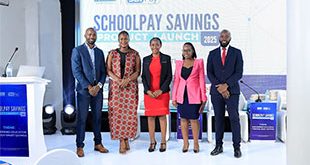
By Patrick Kagenda
They had hoped for even deeper cuts
Uganda Clays pays an average Shs 99 million per month in user fees to Umeme, the electricity distribution company. That is about Shs 1 billion per year or about a quarter of the profit that the housing clay products company hopes to have made in 2009.
So when the Electricity Regulatory Authority (ERA) announced power tariff reductions on December 28, 2009, The Independent asked Uganda Clay’s Chief Executive Officer, John Wafula for a reaction.
“This reduction to us is welcome and we are grateful but we would have wanted a bigger reduction. It is a positive step in the right direction,” he said, ” This is the first time we are seeing power tariffs being revised downwards because all along power tariffs have always been revised upwards”, says Wafula.
Significantly, however, he says the tariff reduction would not have any impact on his company’s product prices.
Wafula was being very polite.
Suresh. C. Sharma the regional director of the African operations of the Mehta Group, the sugar manufacturers was more direct.
“The 1.2-1.3% reduction for us is very low. However, it is a start in the right direction. They should reduce more,” he said.
James Mulwana a re-known Ugandan manufacturer also asked for more.
“Every business would have wanted a bigger reduction, but still we are happy with what we have been given,” said Mulwana.
He explained the dominant view. “As manufacturers we have always been talking about reducing the cost of doing business in Uganda and power has been one of the high costs. In Uganda we have less power and we have been mixing hydro power with the generator power which turns out to be very expensive and making our product s costly. The tariff reduction is a very welcome gesture as it reduces the high cost of doing business in the country.”
In spite of Uganda spending close to around Shs 212 billion annually as power subsidy, Uganda’s power tariff remains the highest in the East African region and the highest in the world over next to Sweden.
In the east African region the Tanzanian domestic power consumer pays Shs 52 per unit, while in Rwanda; domestic electricity consumers are charged Shs 389 per unit. The Kenyan domestic power consumer pays Shs 38.75 per unit for the first 50 units after which consumers pay between Shs 166.26 and 345 per unit depending on consumption. Kenya, Tanzania and Rwanda’s power sources are a combination of hydro, geothermal, gas, methane, solar, wind, and thermal, a practice that mitigates power price increases.
On October 5, 2009 Gen. Salim Saleh who chaired the Interim Review of the Electricity Tariff Committee, told the minister and board members in the boardroom of the Electricity Regulatory Authority (ERA) in Kampala that they had identified areas of cost reduction that should lead to a reduction in the tariff by Shs188 from Shs426 per unit. This implied a tariff reduction of 44%.
The small tariff reduction, therefore, are surprising. The domestic tariff was reduced by 9.5 per cent from Shs426.1 to Shs385.6, a reduction of about Shs40 per unit for the domestic consumer. The commercial tariffs were reduce by 10 per cent from Shs398.8 to 358.6 per unit, medium industries by 9.9 per cent from Shs369.7 to Shs333.2, while large industries were decrease by a marginal 1.2-1.3 per cent from Shs187.2 to Shs184.8 and street lights from Shs403 to Shs364.6.
Gideon Badagawa, the Chief executive at the Uganda manufacturer`s Association (UMA) said his organisation was surprised that domestic consumers had been given a bigger tariff cut. He said he hoped for more tariff cuts if the government rehabilitates the old power lines, attracts more power producers and pays them handsomely unlike the US 6 cents being paid to the Kakira sugar works.
“The tariff cuts are of course related to the east African integration and Common Market,” he said, “Uganda has been one of the high cost producers.”
The high power tariff have made Uganda`s businesses uncompetitive. The power tariff cuts come as the East African Community (EAC) is establishing a power interconnection system within the region. The Eastern Africa Power Pool (EAPP) began development of a Regional Power Master Plan & Grid Code in November last year.
Electricity Regulatory Authority Chief Executive Frank Sebbowa, while announcing the tariff reduction said, increased power generation by new entrants who include Troder power in Bugoye Kasese, Electromaxx in Tororo and Kinyara Sugar works in Masindi and the 2010 loss target for Umeme estimated at 28 percent down from the current 31 percent contributed to the tariff reduction.
He said other factors that led to the tariff cut were improved collection targets, reduced working capital allowances for Umeme and a stronger shilling against the US dollar. Sebbowa added that tariffs would go down further by 27 percent if the government accepted to waive the debts left behind by the defunct Uganda Electricity Board. Perhaps then, the CEO of Uganda Clays and others would not ask for more cuts.
 The Independent Uganda: You get the Truth we Pay the Price
The Independent Uganda: You get the Truth we Pay the Price



